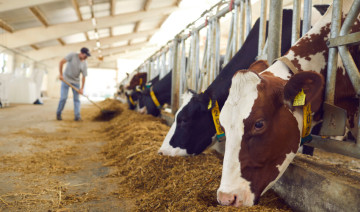
Preparing Your Livestock for Winter: Feed and Shelter Essentials
As winter approaches, it's essential for farmers and livestock owners to ensure their animals are prepared for the cold months ahead. Proper feed, shelter, and health care are critical to keeping livestock healthy and productive during the harsh winter season. In this blog, we'll guide you through key feed and shelter essentials to keep your livestock safe, warm, and well-nourished throughout the winter.
1. Adjusting Feed for Winter Needs
During the winter months, livestock requires additional energy to maintain their body heat and overall health. Here's how to adjust your feeding practices to meet the increased nutritional demands:
Increase Caloric Intake
- Why it’s important: Cold weather increases the energy requirements of animals as they use more calories to stay warm. Livestock will need more calories to maintain their body temperature, especially if they’re kept outdoors or exposed to cold conditions.
- How to adjust: Consider increasing the portion sizes of feed, particularly adding more high-energy grains, like corn, to their diet. Depending on the animal, hay and forage may also need to be increased to meet their energy needs.
Provide Quality Forage
- Why it’s important: Hay is the foundation of many livestock diets, especially in winter when pasture grass is scarce. The quality of the hay you provide is crucial.
- How to adjust: Ensure your livestock has access to high-quality hay, rich in fiber. Good forage helps in digestion, which produces body heat through fermentation in ruminant animals, such as cattle and sheep.
Consider Supplements
- Why it’s important: While good-quality feed and forage provide most nutrients, winter can deplete essential vitamins and minerals that livestock need for overall health.
- How to adjust: Consider supplementing with vitamins A, D, and E, as these are often deficient in winter forage. Additionally, adding mineral blocks or loose mineral supplements to your feeding regimen can help ensure proper nutrition.
Access to Clean Water
- Why it’s important: Proper hydration is just as important in winter as it is in warmer months. Dehydration can occur even in cold weather, especially if water sources freeze over.
- How to adjust: Ensure livestock always have access to fresh, unfrozen water. You may need to invest in heated waterers or regularly break the ice in troughs to prevent dehydration.
2. Providing Adequate Shelter
While many animals are hardy and able to withstand cold weather, providing them with adequate shelter is crucial for their comfort and health. Here are key considerations for winter shelter:
Windbreaks and Protection from the Elements
- Why it’s important: Strong winds, heavy snow, and freezing rain can cause hypothermia and stress in livestock, leading to health problems.
- How to adjust: Ensure your animals have access to windbreaks, either through natural barriers like trees or man-made structures such as sheds or barns. These structures help shield them from cold winds and precipitation.
Ventilation
- Why it’s important: While it’s important to keep animals warm, poor ventilation can lead to a buildup of ammonia and moisture, creating unhealthy air quality and increasing the risk of respiratory issues.
- How to adjust: Make sure that your shelter is well-ventilated without allowing cold drafts to enter. Proper ventilation helps to circulate fresh air and reduce moisture, keeping animals healthier.
Bedding
- Why it’s important: Providing dry, insulated bedding is essential to keep livestock warm and comfortable. Wet bedding can lead to chilled animals, increasing the risk of illness.
- How to adjust: Use straw, shavings, or other absorbent materials as bedding in your shelters. Ensure bedding is kept dry and is regularly replenished to provide proper insulation against the cold ground.
Space Considerations
- Why it’s important: Overcrowded shelters can lead to stress, injuries, and increased risk of disease transmission.
- How to adjust: Make sure there is enough space for all animals to lie down and move around comfortably. Monitor social dynamics, especially in mixed groups, to prevent aggression and ensure all animals have access to shelter.
3. Health Monitoring and Veterinary Care
Winter weather can place stress on livestock, making them more susceptible to illness. Here's how you can help prevent common winter health problems:
Regular Health Checks
- Why it’s important: Identifying early signs of illness or injury can prevent more serious health issues from developing.
- How to adjust: Check your animals daily for signs of weight loss, coughing, limping, or any abnormal behaviors. Early detection can help prevent bigger problems down the road.
Vaccinations and Parasite Control
- Why it’s important: Even in colder months, livestock can still be affected by parasites and diseases, especially if housed in close quarters.
- How to adjust: Consult your veterinarian about appropriate vaccinations and parasite control measures to implement during the winter months.
Hoof and Foot Care
- Why it’s important: Snow, ice, and wet conditions can lead to hoof problems, such as foot rot, which is more common in muddy, wet conditions.
- How to adjust: Regularly trim hooves and keep bedding dry to reduce the risk of infections or injuries. Inspect hooves often for cracks or signs of foot rot.
Conclusion
Proper preparation is key to ensuring your livestock remain healthy and productive during the winter months. By adjusting their feeding regimen, providing well-ventilated and insulated shelter, and maintaining a proactive approach to their health care, you’ll help your animals thrive even in the harshest weather. Taking these essential steps will not only ensure your livestock's well-being throughout the winter but also set the stage for a successful and healthy spring season.
Happy farming!
